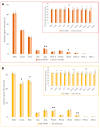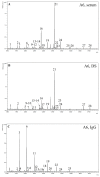Alterations in the Glycan Composition of Serum Glycoproteins in Attention-Deficit Hyperactivity Disorder
- PMID: 37240090
- PMCID: PMC10218324
- DOI: 10.3390/ijms24108745
Alterations in the Glycan Composition of Serum Glycoproteins in Attention-Deficit Hyperactivity Disorder
Abstract
Changes in protein glycosylation are associated with most biological processes, and the importance of glycomic analysis in the research of disorders is constantly increasing, including in the neurodevelopmental field. We glycoprofiled sera in 10 children with attention-deficit hyperactivity disorder (ADHD) and 10 matching healthy controls for 3 types of samples: whole serum, sera after depletion of abundant proteins (albumin and IgG), and isolated IgG. The analytical methods used were a lectin-based glycoprotein microarray enabling high-throughput glycan analysis and matrix-assisted laser desorption/ionization time-of-flight (MALDI-TOF) mass spectrometry (MS) as a standard method for the identification of glycan structures. For microarray analysis, the samples printed on microarray slides were incubated with biotinylated lectins and detected using the fluorescent conjugate of streptavidin by a microarray scanner. In the ADHD patient samples, we found increased antennary fucosylation, decreased di-/triantennary N-glycans with bisecting N-acetylglucosamine (GlcNAc), and decreased α2-3 sialylation. The results obtained by both independent methods were consistent. The study's sample size and design do not allow far-reaching conclusions to be drawn. In any case, there is a strong demand for a better and more comprehensive diagnosis of ADHD, and the obtained results emphasize that the presented approach brings new horizons to studying functional associations of glycan alterations in ADHD.
Keywords: ADHD; MALDI-TOF mass spectrometry; biomarker; glycosylation; lectin-based glycoprotein microarray.
Conflict of interest statement
The authors declare no conflict of interest.
Figures



Similar articles
-
Altered N-glycan profile of IgG-depleted serum proteins in Hashimoto's thyroiditis.Biochim Biophys Acta Gen Subj. 2020 Mar;1864(3):129464. doi: 10.1016/j.bbagen.2019.129464. Epub 2019 Oct 26. Biochim Biophys Acta Gen Subj. 2020. PMID: 31669586
-
Influence of media composition on recombinant monoclonal IgA1 glycosylation analysed by lectin-based protein microarray and MALDI-MS.J Biotechnol. 2020 May 20;314-315:34-40. doi: 10.1016/j.jbiotec.2020.03.009. Epub 2020 Apr 13. J Biotechnol. 2020. PMID: 32298669 Free PMC article.
-
A Novel Mass Spectrometry Platform for Multiplexed N-Glycoprotein Biomarker Discovery from Patient Biofluids by Antibody Panel Based N-Glycan Imaging.Anal Chem. 2019 Jul 2;91(13):8429-8435. doi: 10.1021/acs.analchem.9b01445. Epub 2019 Jun 20. Anal Chem. 2019. PMID: 31177770 Free PMC article.
-
MALDI Mass Spectrometry Imaging of N-Linked Glycans in Tissues.Adv Exp Med Biol. 2018;1104:59-76. doi: 10.1007/978-981-13-2158-0_4. Adv Exp Med Biol. 2018. PMID: 30484244 Review.
-
Analysis of N- and O-linked glycans from glycoproteins using MALDI-TOF mass spectrometry.Methods Mol Biol. 2009;534:5-21. doi: 10.1007/978-1-59745-022-5_1. Methods Mol Biol. 2009. PMID: 19277556 Review.
Cited by
-
The long way to diagnosis: attention disorder, alcohol addiction or congenital disorder of glycosylation? A case report.BMC Psychiatry. 2025 Apr 29;25(1):435. doi: 10.1186/s12888-025-06862-9. BMC Psychiatry. 2025. PMID: 40301838 Free PMC article.
-
Deciphering disease through glycan codes: leveraging lectin microarrays for clinical insights.Acta Biochim Biophys Sin (Shanghai). 2024 Aug 1;56(8):1145-1155. doi: 10.3724/abbs.2024123. Acta Biochim Biophys Sin (Shanghai). 2024. PMID: 39099413 Free PMC article. Review.
-
Glycosylation Pathways Targeted by Deregulated miRNAs in Autism Spectrum Disorder.Int J Mol Sci. 2025 Jan 17;26(2):783. doi: 10.3390/ijms26020783. Int J Mol Sci. 2025. PMID: 39859496 Free PMC article.
-
Glucosamine-loaded injectable hydrogel promotes autophagy and inhibits apoptosis after cartilage injury.Heliyon. 2023 Sep 7;9(9):e19879. doi: 10.1016/j.heliyon.2023.e19879. eCollection 2023 Sep. Heliyon. 2023. PMID: 37809776 Free PMC article.
-
Predicting psychiatric risk: IgG N-glycosylation traits as biomarkers for mental health.Front Psychiatry. 2024 Nov 22;15:1431942. doi: 10.3389/fpsyt.2024.1431942. eCollection 2024. Front Psychiatry. 2024. PMID: 39649366 Free PMC article.
References
-
- Santos S., Ferreira H., Martins J., Gonçalves J., Castelo-Branco M. Male sex bias in early and late onset neurodevelopmental disorders: Shared aspects and differences in Autism Spectrum Disorder, Attention Deficit/hyperactivity Disorder, and Schizophrenia. Neurosci. Biobehav. Rev. 2022;135:104577. doi: 10.1016/j.neubiorev.2022.104577. - DOI - PubMed
-
- Association A.P. Neurodevelopmental Disorders: DSM-5® Selections. American Psychiatric Association Publishing; Washington DC, USA: 2015.
MeSH terms
Substances
Grants and funding
LinkOut - more resources
Full Text Sources
Medical

